These DIY dryer sheets are a solution for people who are sensitive to fragrance and they’ll generate less waste, too.
Originally contributed by Chris Dalziel in October 2016; this post has been updated.
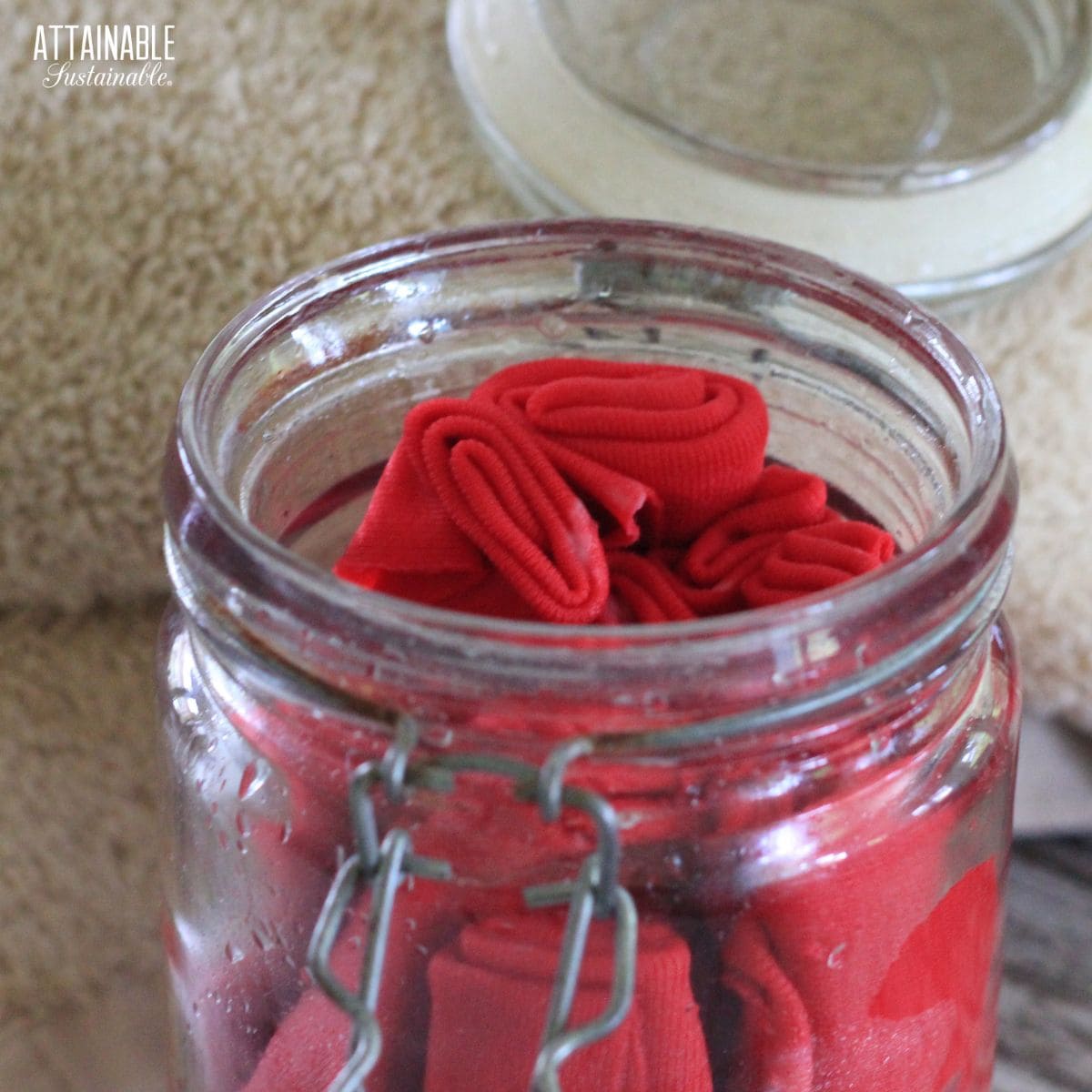
That April Fresh Scent
My neighbor in the city used dryer sheets pretty much constantly. With two teenagers in the house and a plumber for a husband, she did a few loads of wash every day, except Sunday. Her dryer vented in the direction of my garden. I couldn’t weed the garden without a strong “April Fresh” scent wafting my way.
At my son’s house in the city, his neighbor also has that April Fresh scent emitting from his laundry vent. The polyester spun cloth dryer sheets, though, besides being expensive, are persistent in the environment. They are plastic. Like other petroleum based products, they don’t compost and they can’t be recycled. (If you make your DIY dryer sheets from cotton t-shirts, you can toss them in your compost pile when they start to fall apart.)
What do Dryer Sheets do?
Dryer sheets contain a thin layer of chemical lubricant that softens clothing. The lubricant is electrostatically conductive to reduce static electricity. When the dryer sheets are tumbled in the heat of the dryer, the lubricant is released from the dryer and moves into the clothing.
That’s why your dryer sheets look so frail when they come out of your dryer. The chemical on them has now permeated your clothing and the environment outside your dryer vent. Any fragrance on the dryer sheet is also released during the tumble. What isn’t absorbed by the clothes is released into the environment through the dryer vent. (Don’t homemade dryer sheets sound better to you??)
Take a Peek Inside My Book!
Get a free excerpt from my book, Attainable Sustainable: The Lost Art of Self-Reliant Living! You’ll also get my free weekly newsletter, complete with recipes, gardening tips, and a little peek at what’s going on around here — both the zany and the mundane.
Related: How to Make Fabric Bags for Fresh Produce
Supplies
Fabric — 100% cotton is your best bet here as it’s soft and absorbent. Look for knit, not woven, shirts and blankets or towels, as they won’t require hemming. No frays and saves you a lot of time!
Vinegar — Just plain white vinegar here. Many people use it directly in their washer as a fabric softener. It will also inhibit mold growth AND I promise your laundry won’t smell like vinegar!
Hair conditioner — This will add some scent to your dryer sheets. You could also use essential oils.
Jar — I prefer the type with an attached lid, but you could also use the screw on lids.
How to Make Reusable DIY Dryer Sheets
DIY dryer sheets can be made from recycled clothing like sweat shirts, tee shirts, or other medium weight knit fabric. Soaked in a solution that softens your laundry, these DIY dryer sheets reduce static. Scent them with essential oils for freshness. They not only remove a piece of worn out clothing out of the landfill cycle, these DIY dryer sheets save you money, since they can be used over and over again.
Homemade dryer sheets are easy to make from upcycled t-shirts. Cut the seams out of the t-shirts and to create flat portions of fabric, and then tear or cut those into roughly 10″ squares.
Roll up and soak the squares in a vinegar solution and toss one into each dryer load instead of commercial dryer sheets.
Related:Reusable Snack Bags: An Eco-Friendly Food Wrap with Less Waste
FAQs
How do I store DIY dryer sheets?
I use a glass jar as I think it looks pretty. It also seals up well so the cloths don’t dry out. If you happen to have a plastic tub from baby wipes, that would also be a great way to recycle! Also if you have children doing their own laundry, or your laundry room is in the basement with a concrete floor, you might feel safer using something that is plastic just in case of drops.
Once a dryer sheet has been used, have a basket or second empty jar to keep them in. Once they are all used up you are ready to mix up some fresh solution! Just give the used jar a quick rinse.
What fabric is best for dryer sheets?
I prefer cotton, and I love to epicycle shirts. Save t-shirts that have gotten paint on them or other stains. You can also use washcloths if you find 100% cotton. Just ensure they aren’t fraying or they will add strings to your clean laundry. Also use older fabrics so the dye is already set and won’t run in the vinegar solution.
★ Did you make these DIY dryer sheets? Don’t forget to give them a star rating below! ★
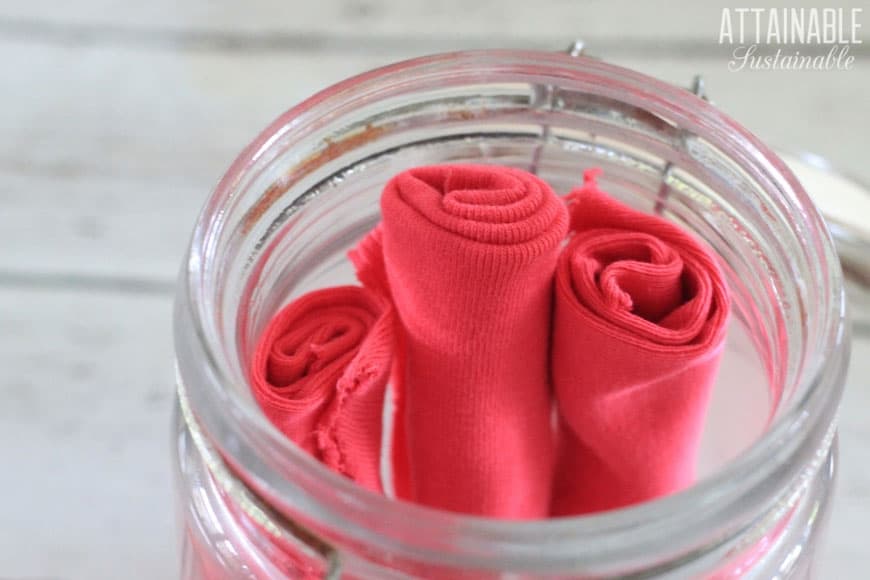
DIY Dryer Sheets
Equipment
- Pinking shears
- 1 glass 1 quart jar with a bail and trigger lid
Ingredients
- 2 100% cotton T-shirts knit shirts, or waffle-weave knit tops
- 1 ½ cups white vinegar
- 1 teaspoon lavender, eucalyptus, or lemon essential oil
- ½ teaspoon hair conditioner or Cowboy Magic hair detangler optional
Instructions
- Wash and dry the shirts to get them ready to upcycle. Knit fabrics are best for this project, since they don’t unravel after cutting.
- Using pinking shears, cut the shirts along both sides of each seam to separate the front from the back. Fold each piece in half along the middle of the fabric, putting shoulder seams together and the bottom edge together. With pinking shears, cut the fabric along the fold to create two pieces of fabric from each front and back.
- Fold each piece of fabric placing the bottom edge of the fabric against the neck cut out. You will have a small part of the neck and shoulder outside the doubled fabric. Cut this off, so that you have a rectangle with straight edges. One dryer sheet made. Repeat this with the other four pieces of fabric from this shirt.
- You will have sleeves, and shoulder pieces leftover from this project. Save them for another use. Repeat steps two and thre with the second shirt. You will have eight pieces of prepared fabric in all.
- Pour the white vinegar, essential oil, and hair conditioner (if you are using it) into a two-cup glass measuring cup. The hair conditioner prevents static cling. If you are in a high humidity area and static is not a concern, the hair conditioner can be omitted from the recipe. The vinegar is a softener and the essential oils contribute a fresh scent that is also an insect repellent.
- Roll each piece of fabric into a tight roll that fits inside your jar. Place the fabric into the jar.
- Pour the vinegar solution into the jar, over all the pieces of fabric. Put the lid on the jar.
- Allow this to sit overnight so that the fabric can absorb the vinegar solution. There will be no pool of vinegar on the bottom of the jar when the fabric has fully absorbed the vinegar solution.
To use:
- Place a wet DIY dryer sheet in your dryer with your laundry load. The vinegar smell dissipates when the fabric is dry.
- Used dryer sheets can be recharged with a fresh vinegar solution and reused multiple times.
- After use, roll the dryer sheets up and place them in a second glass jar. Add fresh vinegar solution when the second jar is full of dryer sheets.
- In this way, you’ll always have dryer sheets ready when you need them.
- Tip: For the hair conditioner in the recipe, I use the small bottles of hair conditioner that you get for free when you stay in a hotel.
- The hotel has to throw the unused portion out, so by taking them with you keep them out of the landfill.
Notes
- If you don't have pinking shears, you can simply use fabric scissors to make a snip into the t-shirt fabric. Grip with one hand on each side of the notch and pull to tear the fabric apart easily.
Six Ways to Green Up Your Laundry Routine
DIY dryer sheets aren’t the only way to reduce the amount of chemicals and plastic you generate in the laundry room. You can also try these ideas.
1. Make Your Commercial Dryer Sheets Last Longer
If you use dryer sheets, you can make them last longer by cutting them into halves or thirds so that one package will last longer. This will save you money and in most cases will give you the same static-free, perfumed laundry you’ve come to expect from your laundry products. The average commercial dryer sheet costs five cents a sheet. If you cut them into thirds you’ll bring the cost down to less than two cents a load, without loss of effectiveness.
You’ll also reduce the amount of chemical toxins released into your home.
2. Use Wool Dryer Balls
To soften your laundry and reduce static cling, use wool dryer balls in the dryer in the place of dryer sheets. Wool dryer balls are naturally electrostatic and biodegradable. They also reduce drying time by absorbing some of the moisture from your wet laundry. See my tutorial to make your own wool dryer balls.
While wool dryer balls require an initial investment, you’ll use them over and over again. Add fragrance by placing a single drop of essential oil on the wool dryer ball before using.
3. Use Tin Foil
Crunch up tin foil into balls in your hands, placing the dull side out. (The shiny side is plasticized.) Use tin foil balls in place of dryer sheets. Tin foil reduces static in your laundry load by discharging the static while your wash tumbles. But tin foil balls aren’t a perfect solution. Tin foil is not biodegradable, but it is recyclable in some areas. And unlike DIY dryer sheets, they will need to be replaced after a few wash loads, as it breaks down from the friction of the dryer.
4. Line Dry Your Laundry
Those who are able to line dry their laundry won’t need the April Fresh scent of dryer sheets to make their laundry fresh. Line drying refreshes your laundry without artificial scent. Line drying also reduces static cling. However, those who live in areas of high humidity won’t be able to line dry year round.
5. Remove Your Clothes From the Dryer While Still Damp
Static builds up in dry clothes. If you remove your clothing from the dryer while there is still a slight dampness, you can minimize static build up and reduce your use of chemical dryer sheets.
6. Choose Natural Fabrics
Static builds up in manmade fabrics, especially when natural and manmade fabrics are together in the same laundry load. By choosing cotton and linen clothing over manmade fabrics you can reduce the amount of static in your wash load, and reduce your need for chemical dryer sheets.
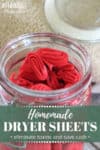

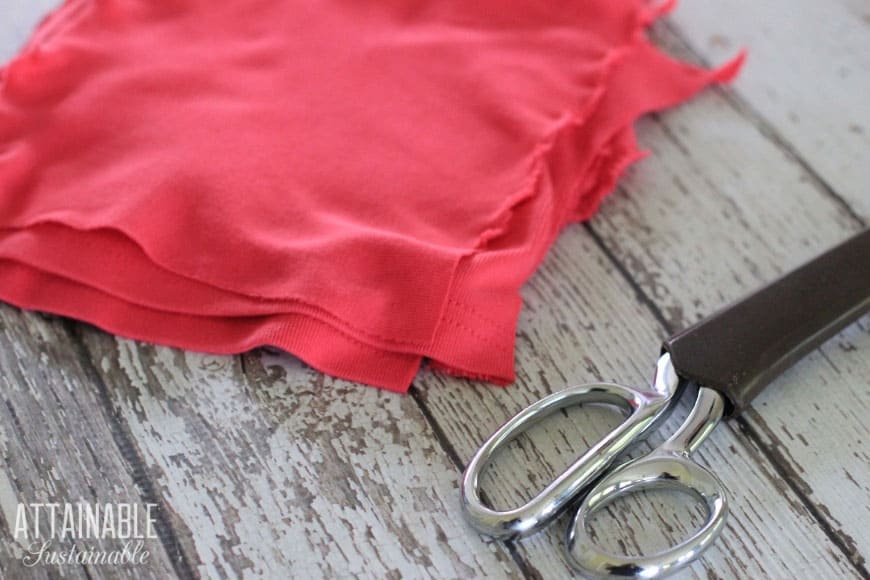
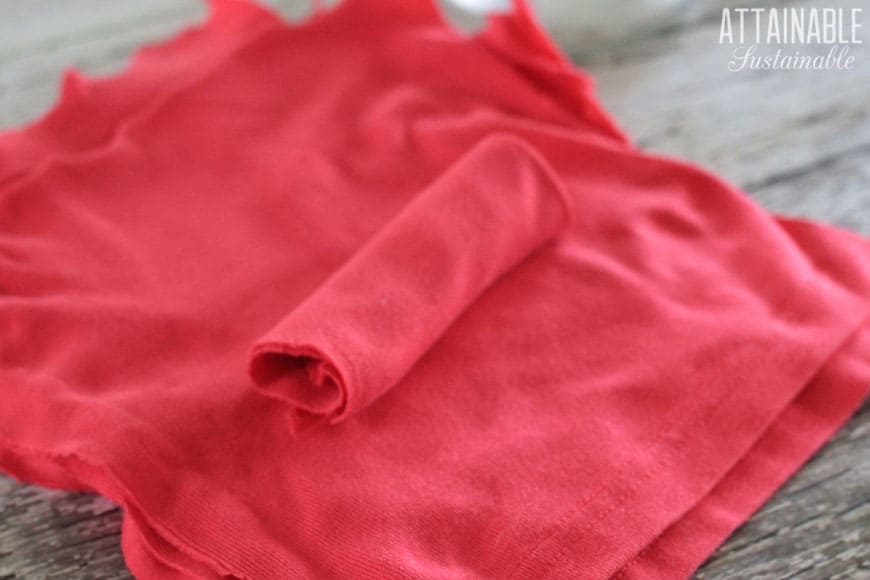
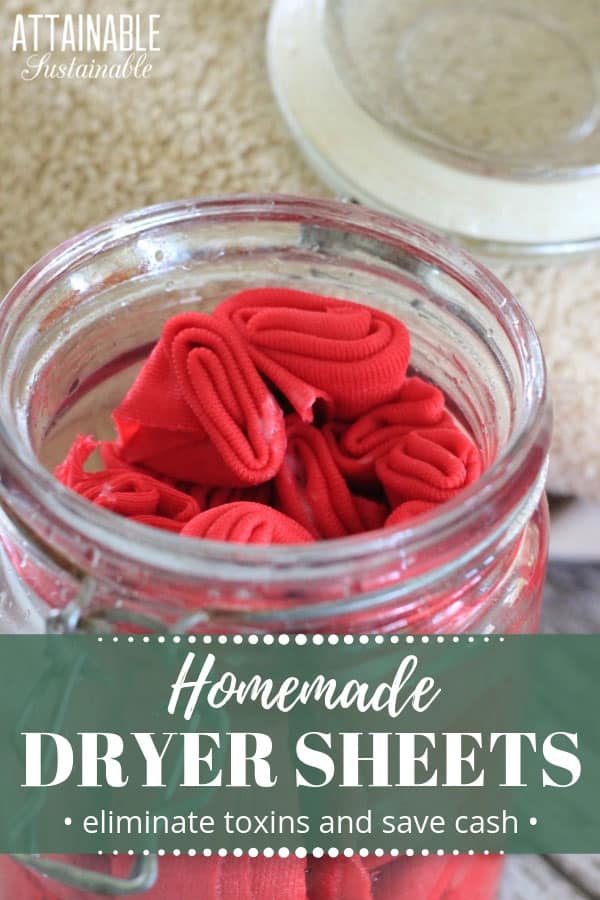
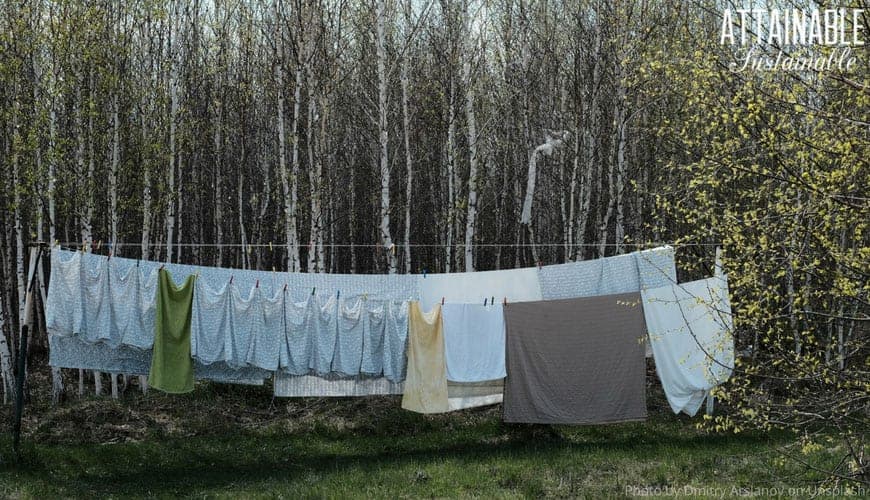




Hello,
I have a bunch of my husband’s old t-shirts that are polyester. I’d like to use them for something instead of throwing them away. Can I use polyester for a reusable dryer sheet or must I use cotton? I understand cotton can be composted and is probably better long-term for general health, but will I cause any actual harm if I use this type of fabric?
Thank you!
I don’t think it will cause any “harm” as you say, but there are a lot of compelling arguments about using it: https://www.thehouseofpillows.eu/polyester-shouldnt-be-in-your-bed-blog/
I’m pleasantly surprised by this post as I wasn’t expecting you to advocate line drying as the preferred option. I’m new to this blog and think I am already a fan.
thank you for the recipe..
I usually use old washcloths dipped in fabric softener & hang on hangers to dry.. they work great dry.
over and over again b4 refreshing..
Could one possibly use Castile Soap instead of store bought conditioners? I cannot handle strong smells and most conditioners are pretty smelly to me.
Krista
The conditioners are used to break the static bonds in the laundry. It can be omitted if you don’t have a major static problem in your area. Alternatively using wool dryer balls, which don’t require anything, once they are made, may be a better option in your circumstance.
Love this post! Thank you!
Too bad it prints an ad right over the instructions. 🙁
Thanks for letting me know. I just added a new – hopefully better – print button. Give it a try!